VINTG IGERT Students Receive
Outside-of-the-Box Training in Genomics
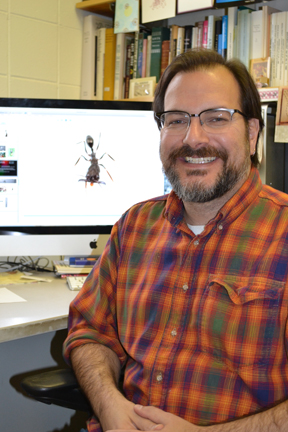
VINTG PI and Director Andy Suarez
November 16, 2012
Nine new doctoral students arrived on campus this fall to receive a new kind of training in genomics that "thinks outside the box." The premise of this training model: to produce a new generation of biologists on the cutting edge of genome-enabled science, who can specifically address how genomes interact with the environment to create diversity. This program, VINTG (Vertically Integrated Training with Genomics), is funded by a National Science Foundation IGERT (Integrative Graduate Education and Research Traineeship) grant.
According to School of Integrative Biology Professor Andy Suarez, PI and Director of the program,"Our goal is to actually use it as a recruiting tool, not simply to put current students on fellowships, but to broaden participation, particularly from groups typically underrepresented in the sciences." VINTG's goal is to recruit 50% of their students from groups typically underrepresented in the sciences.
Students recruited into the program will be IGERT fellows throughout their Ph.Ds. Although they will only be funded directly from NSF for two years, the remainder of their support will come through other grants, fellowships, and/or assistantships via their faculty sponsor or graduate program.
Because the support arrived too late to recruit students the first year of the grant, the VINTG team recruited nine this fall and hope for a total of 30–40 students over the five years of the grant. Of the nine current students, several just finished their undergraduate programs; some have just received a Masters. Recruited through four or five different graduate programs, students hail from a variety of disciplines, including bioinformatics, anthropology, ecology, evolutionary biology, and microbiology.

VINTG PI and Director Andy Suarez at work in his lab in Morril Hall. Suarez's current research emphsis is on ant genetics and biological invasions.
Suarez and company hope to train scientists capable of addressing some of the grand challenges and questions facing biology today. For example, scientists worried about the sheer amount of data being created with genome-enabled biology today wonder, "How is that going to impact personalized medicine? Are we someday going to have all of our genome sequenced and can relate our needs for medicine to that? How do you handle those kinds of data sets?..."How are organisms responding to changes in climate or habitat loss? What can we learn about embracing the natural variation that occurs within a population?
"Ultimately," suggests Suarez, "all of these questions relate back to this issue: organisms have a genome…that genome interacts with the environment to result in expression that creates the phenotypes that we see. So if you want to understand how that genome is organized and how it interacts with environmental variation to create diversity, you really need to know a lot about that organism and a lot about the sources of variation and how those components interact."
Suarez reports that in training models in the past, tools were restricted to a few model organisms, like the fruit fly and the mouse, while researchers worked to minimize environmental variation.
"However," he explains, "now we are able to develop these genetic and genomic tools for any organism. So we're in a very unique situation in which we can start addressing questions that capitalize on natural population genetic variation with genomic tools for any organism. We can choose organisms not just because they're easy to breed in the lab, but because they exhibit characteristics that we want to study."
VINTG's goal is to train future biologists who embrace variation rather than ignore it. Thus, rather than being restricted to studying model organisms, VINTG fellows are branching out to research birds, bees, ants, humans, and even cancer cells.
The designers of this new type of training program have tried to think outside the box. Having concluded that the traditional training model—becoming an expert in physiology or genetics alone—may not be broad enough, they encourage students to really get to know their organism's ecology, evolution, behavior, physiology, and genetics.
Plus, in the VINTG model, students need expertise in bioinformatics and statistics to interpret the copious amounts of data now obtainable. So one of the project's co-PIs, Sandra Rodriguez-Zas, an Animal Sciences bioinformatician accustomed to tackling large genomic data sets, has designed a new course to train students not only in basic statistics, but in management skills needed to handle large data sets.
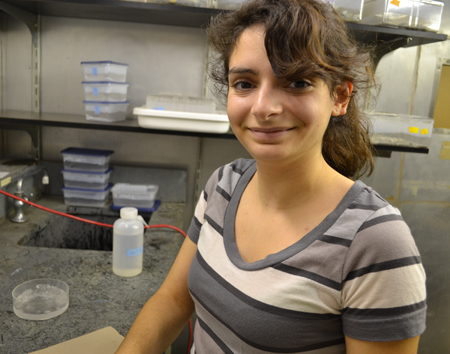
VINTG IGERT fellow Selina Ruzi in the Suarez lab at Morrill Hall.
VINTG students are currently enrolled in a required graduate education orientation seminar addressing how to be a good student and write grants, and time managementstrategies to make the most of seminars and reading literature. In January, students will journey to Panama to interact with Smithsonian Tropical Research Institute faculty, hear lectures on diversity in a tropical climate, do field experiments, start on group projects, and collect data. Armed with the data, they will return to campus for a statistics course to learn how to analyze these large data sets.
Of their training model, Suarez asks, "Can we really do all that, or are we asking too much?" The team believes fostering synergistic relationships and collaboration is key. "We're hoping by recruiting students from a wide variety of backgrounds, each of which will have some information, encouraging through team-building exercises, collaborating with people to be able to answer all of these questions or capitalize on a diversity of approaches."
Is the goal to steer the VINTG fellows toward careers in genomics? Not necessarily. The team wants students to appreciate techniques becoming available and learn how to generate and analyze the data. Their goal is to train students who might be fearful of modern techniques to embrace them and ask a wide variety of questions.
The VINTG project has undergone a paradigm shift since its inception four years ago when Suarez and co-PI Gene Robinson submitted a preproposal to NSF that wasn't funded. Over the next several years, they started working with Debasish Dutta, co-PI and Dean of the Graduate College, who changed the way they were thinking about the IGERT. Suarez recalls the gist of his advice: "While the research is important," Dutta emphasized, "what you're proposing is a new way to train students. So the proposal has to be, 'What is our vision for training students that's outside the box? Oh, and by the way, we do great research.'" Recalls Suarez, "We kind of had it backwards."
Other PIs include Carla Cáceres, Director of Integrative Biology's Program in Ecology, Evolution, and Conservation Biology (PEEC) and Associate Professor of Animal Biology, who is critical to the training portion of the program, and Owen McMillan, Dean of Academic Programs at the Smithsonian Tropical Research Institute. The partnership with the Smithsonian strengthens the ties with another group of scientists and provides a whole new pool of mentors, plus provides fellows the opportunity for international training. Around 30–40 Illinois faculty participate in VINTG; in addition to the five co-PIs and the 20 faculty who are part of VINTG's core participants; additional faculty participate by mentoring students, as do faculty at the Smithsonian.
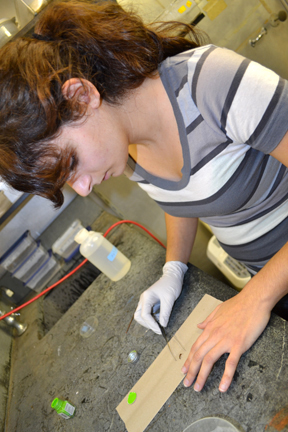
Selina Ruzi works with a trap-jaw ant on which she has just painted a miniscule green dot for identification purposes.
If it weren't for the IGERT, Selina Ruzi, an IGERT fellow who completed her undergraduate degree at Rutgers, reports that she most likely wouldn't be at Illinois, and possibly wouldn't even be in school. "I had originally emailed potential professors whom I thought I could work with in their labs…When I had originally emailed Andy [Suarez], he didn't know about the IGERT; he didn't know that they had gotten it yet. So there wasn't as much of an opportunity here…But with the IGERT, it opened up new possibilities. It's kind of really amazing; I'm so glad I'm here."
Ruzi, who as an undergrad worked with garlic mustard, an invasive plant, and the cabbage white butterfly, an agricultural pest, is interested in invasion ecology, mostly dispersal; restoration ecology; and plant-animal interactions, with a focus on plants and ants.
Regarding her experience so far, she indicates that working with mentor Suarez has been positive. "It's good. It's a lot different than my undergraduate, but I like it a lot. He's really helpful, and he reads all my proposals and is just around to talk, which is nice." She also appreciates what she's learning in the orientation seminar: "It's nice to have that experience, so you know how to write grants and proposals. It's very helpful."
The opportunity to do field work in another country evidently was part of the appeal to Ruzi, who in response to a query about how the program was going, replied: "It's awesome. We'll be in Panama next semester."
Ruzi also is excited about the cutting-edge training in genomics she is receiving: "It's an amazing opportunity to learn new techniques…I don't have a genomic background, but because they're going to teach us, I have these new opportunities to study organisms in a way I didn't think I could originally."
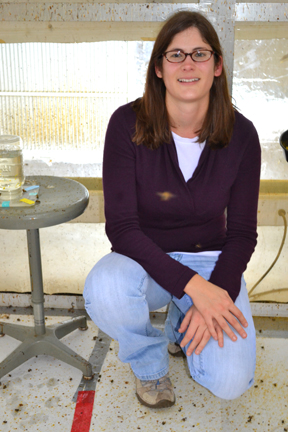
VINTG IGERT fellow Beryl Jones.
Another IGERT fellow, Beryl Jones, heard about VINTG while interviewing for PEEC and was invited to apply. Jones, who is working with Gene Robinson, has a love affair with bees. She indicates, "As an undergrad, I joined a behavior lab in my third year at University of Arizona that studied learning in bumble bees and was hooked." In fact, she's crazy about all social insects. She worked with bumble bees first for about three years as an undergrad, studying learning in bumble bees. Then she went to Brazil for a summer, where she worked with wasps. After receiving her undergraduate degree, Jones spent a year working as a technician in a USDA honey bee lab in Tucson before coming to Illinois as a grad student.
Says Jones: "So as soon as I started working with bumble bees, I was set on social insects. I just find them really fascinating."
Jones reports that in Panama, she won't be working with honey bees, but with halictid bees (sweat bees). Unlike honeybees, which always live in a social colony containing a reproductive queen and sterile workers, halictid bees can be either solitary or social. This behavioral variation in sweat bees is what interests Jones, as she hopes to discover the molecular mechanisms underlying sociality.
Jones is especially passionate about how sociality evolved in bees: "So if I can look at one species and say, 'What makes this bee solitary? What makes them social? And how does the division of labor in the social colony work?' then we can start answering questions."
Regarding her research in Panama, Jones has already been planning, especially since one of the Smithsonian professors works with halictids. She hopes to use the behavioral flexibility in these bees to compare gene expression patterns between reproductive workers to those of regular workers and queens. "If we can make a worker bee 'queen-like,' we can start asking which genes are involved in social behavior."
Quite pleased with this first batch of students, Suarez describes them in glowing terms: "They're brilliant. They're super exciting. They seem really passionate about their own systems, but there's evidence that they're already starting to work together to think about bigger questions."
Story and photographs by Elizabeth Innes, Communications Specialist, I-STEM Education Initiative
More: Biology, Funded, Grad, Underserved Minorities, IGERT
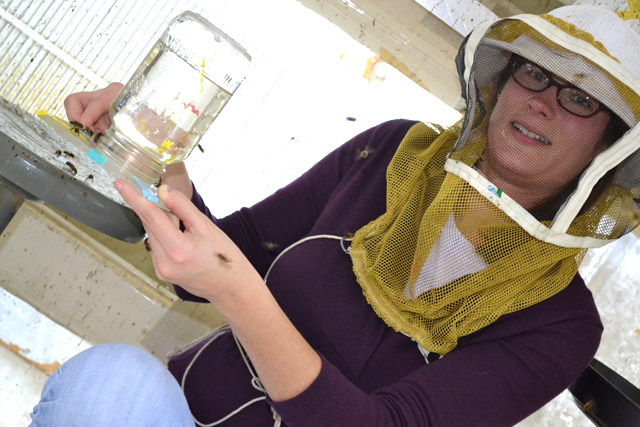
Honeybees at the Bee Research Facility on campus are drawn to the sugar water held by VINTG IGERT fellow Beryl Jones.
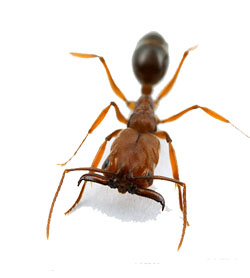
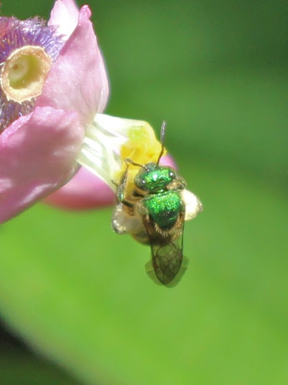













.jpg)
















